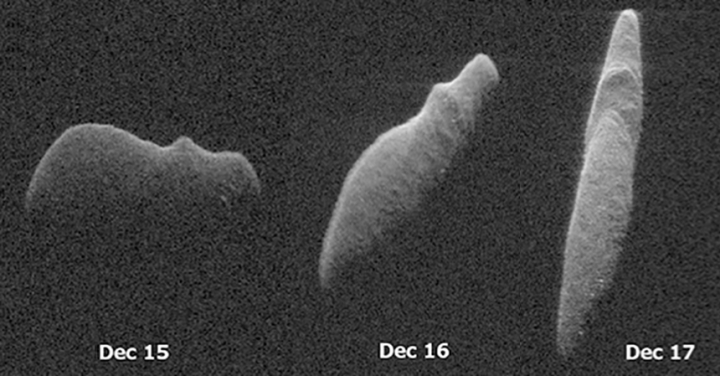New asteroid radar images

Cool radar images! The set of radar images above of near-Earth asteroid 2003 SD220 were created by combining radar data from three different radar telescopes on Earth, Arecibo in Puerto Rico, Green Bank in West Virginia, and Goldstone in California. As the press release notes:
The asteroid will fly safely past Earth on Saturday, Dec. 22, at a distance of about 1.8 million miles (2.9 million kilometers). This will be the asteroid’s closest approach in more than 400 years and the closest until 2070, when the asteroid will safely approach Earth slightly closer.
The radar images reveal an asteroid with a length of at least one mile (1.6 kilometers) and a shape similar to that of the exposed portion of a hippopotamus wading in a river.
The images have a resolution of 12 feet per pixel, so a close look should be able to reveal any large boulders, should they exist. Instead, I see a soft surface that to me resembles the surface of a sand dune, floating unattached to anything in space.
On Christmas Eve 1968 three Americans became the first humans to visit another world. What they did to celebrate was unexpected and profound, and will be remembered throughout all human history. Genesis: the Story of Apollo 8, Robert Zimmerman's classic history of humanity's first journey to another world, tells that story, and it is now available as both an ebook and an audiobook, both with a foreword by Valerie Anders and a new introduction by Robert Zimmerman.
The print edition can be purchased at Amazon or from any other book seller. If you want an autographed copy the price is $60 for the hardback and $45 for the paperback, plus $8 shipping for each. Go here for purchasing details. The ebook is available everywhere for $5.99 (before discount) at amazon, or direct from my ebook publisher, ebookit. If you buy it from ebookit you don't support the big tech companies and the author gets a bigger cut much sooner.
The audiobook is also available at all these vendors, and is also free with a 30-day trial membership to Audible.
"Not simply about one mission, [Genesis] is also the history of America's quest for the moon... Zimmerman has done a masterful job of tying disparate events together into a solid account of one of America's greatest human triumphs."--San Antonio Express-News

Cool radar images! The set of radar images above of near-Earth asteroid 2003 SD220 were created by combining radar data from three different radar telescopes on Earth, Arecibo in Puerto Rico, Green Bank in West Virginia, and Goldstone in California. As the press release notes:
The asteroid will fly safely past Earth on Saturday, Dec. 22, at a distance of about 1.8 million miles (2.9 million kilometers). This will be the asteroid’s closest approach in more than 400 years and the closest until 2070, when the asteroid will safely approach Earth slightly closer.
The radar images reveal an asteroid with a length of at least one mile (1.6 kilometers) and a shape similar to that of the exposed portion of a hippopotamus wading in a river.
The images have a resolution of 12 feet per pixel, so a close look should be able to reveal any large boulders, should they exist. Instead, I see a soft surface that to me resembles the surface of a sand dune, floating unattached to anything in space.
On Christmas Eve 1968 three Americans became the first humans to visit another world. What they did to celebrate was unexpected and profound, and will be remembered throughout all human history. Genesis: the Story of Apollo 8, Robert Zimmerman's classic history of humanity's first journey to another world, tells that story, and it is now available as both an ebook and an audiobook, both with a foreword by Valerie Anders and a new introduction by Robert Zimmerman.
The print edition can be purchased at Amazon or from any other book seller. If you want an autographed copy the price is $60 for the hardback and $45 for the paperback, plus $8 shipping for each. Go here for purchasing details. The ebook is available everywhere for $5.99 (before discount) at amazon, or direct from my ebook publisher, ebookit. If you buy it from ebookit you don't support the big tech companies and the author gets a bigger cut much sooner.
The audiobook is also available at all these vendors, and is also free with a 30-day trial membership to Audible.
"Not simply about one mission, [Genesis] is also the history of America's quest for the moon... Zimmerman has done a masterful job of tying disparate events together into a solid account of one of America's greatest human triumphs."--San Antonio Express-News


Whoa!
I thought the supposed 10:1 geometry of Omuamua, derived from the observed light curve had to be due to something other than the geometry.
But look at this. Direct visual imagery of an celestial body that’s roughly 10:1.
Obviously it must be an evil Zorgon battle cruiser. They are scanning us with their sensors
to determine our weaknesses and formulate their battle plan. Then they will destroy the
Earth and turn us all into meat pies.
Unless all that talk that Omuamua “can’t!” be a natural object because it is so elongated
is just a bunch of twaddle and in fact elongated asteroids are common as dirt.
( Oooops. I mean, common as loosely gravitationally bound piles of regolith.)
It does rather look like a hippopotamus. Perhaps instead of calling it “2003 SD220” we
should indeed call it “the hippopotamus.”
The middle one looks like an amphora.
Romans imported Martian olive oil.